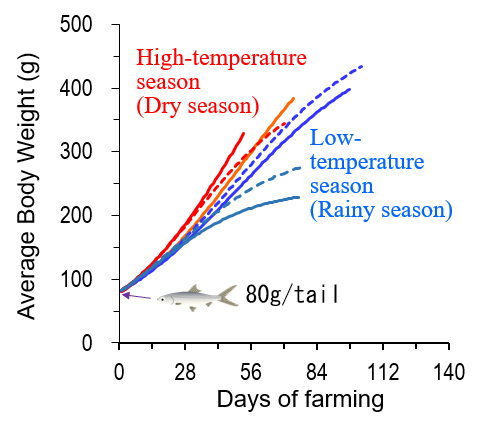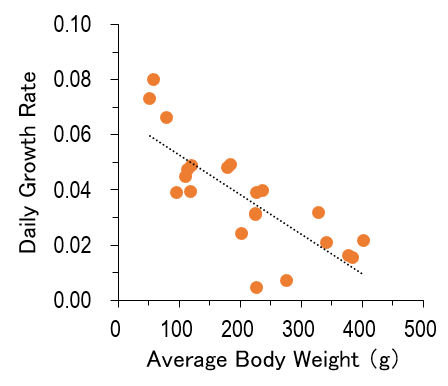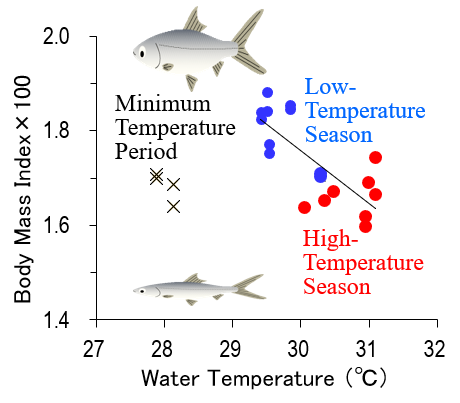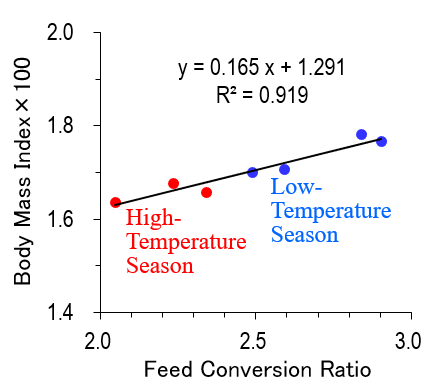Predicting body growth and body mass index of farmed milkfish in the Philippines from water temperature
Description
Information on the growth of farmed fish is important for aquaculture production planning and cost management. It also helps aquaculture managers understand the quality (fat content) and health status of farmed fish, including milkfish. Milkfish is the most important aquaculture target species in the Philippines. However, although milkfishes are actually raised in open-air conditions, only a few previous studies have focused on water temperature. Therefore, this study aimed to clarify the impact of changes in open-air water temperature on milkfish growth and body mass index.
A logistic model for growth (weight) of farmed milkfish was proposed as the most applicable statistical model, with data sampling conducted in high-temperature and low-temperature seasons (Fig. 1). In accordance with common fish farming practice, the experiment was conducted with satiated (full) feeding. The results show that the daily growth rate decreases as milkfish size increases (Fig. 2). The growth model also reflects these physiological characteristics. Regarding the relationship between body mass index and water temperature, body mass index (fat content) increases during low-temperature season (around 29-30°C) and decreases during high-temperature season (>30°C). The body mass index also decreases during the minimum temperature period (27-28°C) in low-temperature season (Fig. 3). As for the relationships among body mass index, water temperature, and feed conversion rate, feed conversion rate and body mass index decrease during high-temperature season. Conversely, they increase during low-temperature season (Fig. 4).
Previous studies have generally used linear regression analysis for estimating fish growth, which tended to exceed growth estimates up to the shipping size (300-400 g/fish). However, this model can be adjusted for such overestimates, and farm managers can utilize the model for more accurate growth and shipping forecasts. Based on the relationship between fish weight and growth rate, it is possible to predict the optimal size of fish to ship for efficient aquaculture business. However, because cost is not analyzed, it is not possible to estimate the optimal size for operating an aquaculture business from this research. Body mass index can be estimated from water temperature using the results; however, further data collection and model modification are needed to make more precise predictions. This research can provide insights for the amount of feed that should be fed at certain temperatures, for example, reducing the amount of feed during low-temperature season and keeping the level of fat constant throughout the year. Feeding cost represents the largest proportion of costs in fish aquaculture business, and the results of this research can contribute to guideline development and cost reduction.
Figure, table
-
Fig. 1. Examples of weight growth estimation for different conditions as seasons
Solid and dashed lines are different farm facility locations. Experiments were conducted three times during the high-temperature season and four times during the low-temperature season. Starting with seedlings weighing 80 g/tail. -
Fig. 2. Relationship between daily growth rate and fish weight
Daily growth rate = 100 × exp (((ln(Wf) –ln(Wi))/farming period) –1).
Wf is the weight at the time of measurement (g) and Wi is the weight at the beginning of farming (g). -
Fig. 3. Relationship between body mass index and water temperature
Body Mass Index = weight (g)/(length (cm))2. Red dots correspond to BMI during high-temperature season, blue dots correspond to BMI during low-temperature season, and X marks indicate BMI during minimum temperature period. -
Fig. 4. Relationship between body mass index and feed conversion ratio
Feed conversion ratio = total feed consumed(g)/total weight of product produced(g). Data of the minimum temperature period are not included.
Figures reprinted/modified with permission from Kodama et al. (2021).
- Classification
-
Research
- Research project
- Program name
- Term of research
-
FY 2016–2018
- Responsible researcher
-
Kodama Masashi ( National Research Institute of Fisheries Science )
Diamante Rose Ann ( Southeast Asian Fisheries Development Center )
Salayo Nerissa ( Southeast Asian Fisheries Development Center )
Castel Raisa Joy ( Southeast Asian Fisheries Development Center )
Sumbing Joemel ( Yokohama National University )
- ほか
- Publication, etc.
-
Kodama M et al. (2021) JARQ 55: 191−200https://doi.org/10.6090/jarq.55.191
- Japanese PDF
-
2021_B07_ja.pdf420.14 KB
- English PDF
-
2021_B07_en.pdf299.45 KB
- Poster PDF
-
2021_B07_poster.pdf294.81 KB
* Affiliation at the time of implementation of the study.




